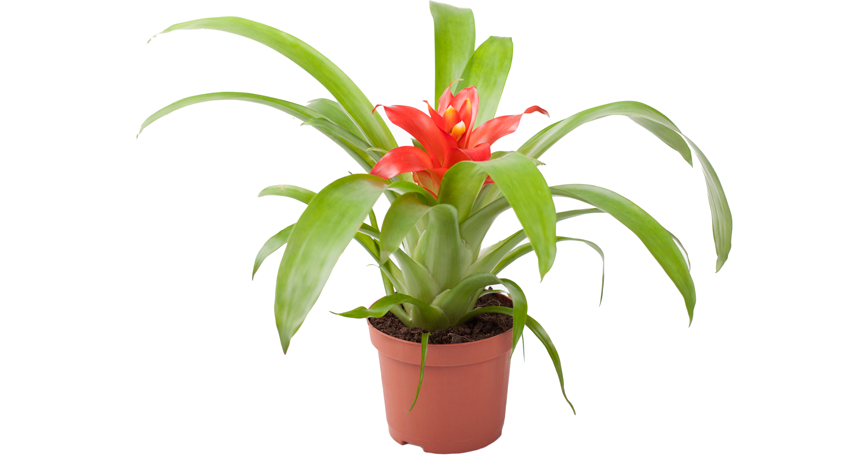Houseplants suck up air pollutants that can sicken people
Bromeliads are good at removing toxic chemicals from the air, new data show

The humble bromeliad, found in homes across America, is actually a star when it comes to cleaning up the air.
Severga/istockphoto
With their stiff leaves and large spiky flowers, bromeliads can add drama to a plant stand or window sill. They are not the flashiest of houseplants. Still, some pollution scientists are ready to give them raves. Their new data show these plants are superstars when it comes to cleaning the air.
Paints, furniture, photocopiers and printers, cleaning supplies and dry-cleaned clothes can all release a family of toxic gases into indoor air. As a class, these gases are known as volatile organic chemicals, or VOCs. Inhaling a number of them can cause dizziness, allergic reactions — even asthma. Long-term exposure might lead to liver damage, kidney damage or cancer.
This is important because people often can’t smell these chemicals. They also can’t stop breathing when a room’s air becomes polluted, notes Vadoud Niri. He is a chemist at the State University of New York at Oswego. And once VOCs enter a room’s air, there’s no way to pull them out again. People can’t vacuum them out.
But certain types of greenery can suck the pollutants up, which keeps them safely away from us.
A single bromeliad houseplant can remove at least 80 percent of six different VOCs from the air inside a 76-liter (20-gallon) container, Niri found. In tests, other houseplants also filtered out VOCs. But none performed as well as the bromeliad.
Niri presented his group’s new data on August 24 at the annual meeting of the American Chemical Society in Philadelphia, Pa.
Not a surprise
In the 1980s, scientists with the National Aeronautics and Space Administration, or NASA, investigated houseplants’ ability to cleanse the air of VOCs. All of the tested plants pulled out at least some VOCs.
But in those tests, each plant was exposed only to one type of VOC at a time. In the real world, indoor air contains a mix of them. So Niri and his colleagues wanted to know what would happen if plants were exposed to a mix of VOCs.
His team exposed five common houseplants — a bromeliad, Caribbean tree cactus, dracaena (Dra-SEE-nuh), jade plant and spider plant — to eight common VOCs. Each plant lived for a while with these pollutants in the 76-liter container (about the size of a car’s gas tank).
Certain plants were better than others at removing a particular VOC. For instance, all five plants removed acetone (ASS-eh-tone) — a smelly VOC in nail polish remover. But after 12 hours, the dracaena had cleared out 94 percent of this gas — more than any of the other plants.
Meanwhile, the spider plant removed VOCs most speedily. Once placed inside the container, VOC levels started to fall within one minute. But this plant didn’t have staying power.
The bromeliad did. After 12 hours, it had removed more VOCs from the air than any other plant. The two VOCs that it could not filter out — dichloromethane and trichloromethane — were also ignored by the other plants. So in this regard, it was no worse than the others.
Webe Kadima is a chemist who also works at the State University of New York at Oswego. She studies medicinal plants but did not work with Niri on this experiment. Part of her work involves understanding what various plant components do. These include enzymes, which are molecules made by living things to speed up chemical reactions.
Plants absorb VOCs from the air, she explains. Those gases enter through stomata (Stoh-MAA-tuh) — tiny openings in plant leaves and stems. Once inside, the plant’s enzymes break down the VOCs into smaller, harmless chemicals.
“The bottom line is that plants contain molecules that let them clear VOCs from the environment,” says Kadima.
Of course, a house, or even a bedroom, is much bigger than the container Niri and his team used. But their work suggests people might breathe easier if they can figure out what type and how many plants it takes to clean the air in a room. This is important because indoor air usually has three to five times greater concentrations of VOCs than outdoor air.
Niri says he plans to test how many houseplants it takes to clean the air in an average-size room. After that, he will repeat the experiment in a nail salon. With all those bottles of nail polish and remover, the air in those salons tends to have high levels of VOCs, he notes.
While special air filtering machines might do the same job as green plants, they cost a lot more, Niri says. And they are nowhere near as pretty as a bromeliad. Especially one in bloom.







